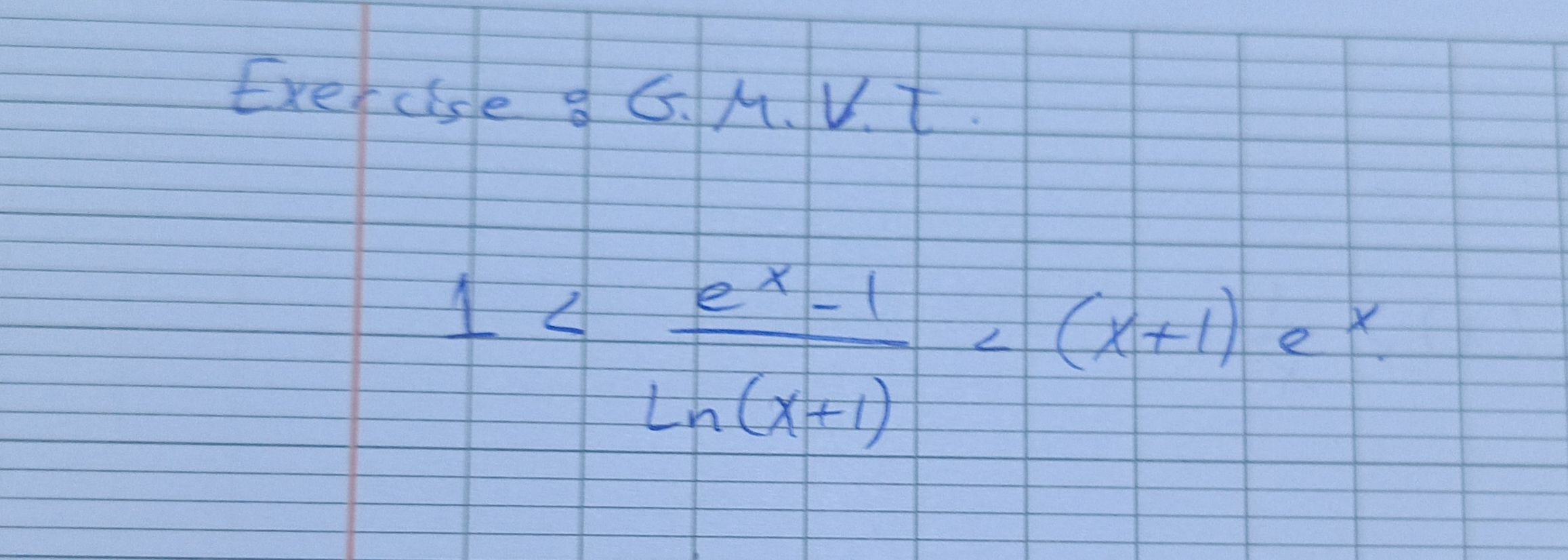Full solution
Q. Exercise: G.M.V.T.
- Understand Given Inequality: First, we need to understand the given inequality 1 < \frac{e^{x}-1}{\ln(x+1)} < (x+1)e^{x}. We have a compound inequality which means we need to solve two separate inequalities: \frac{e^{x}-1}{\ln(x+1)} > 1 and \frac{e^{x}-1}{\ln(x+1)} < (x+1)e^{x}.
- Solve First Inequality: Let's start with the first inequality (e^{x}-1)/(\ln(x+1)) > 1. To solve this, we can multiply both sides by to get rid of the denominator, assuming is positive (which it is for x > 0 since and is increasing for x > 0).(e^{x}-1) > \ln(x+1)
- Check Behavior at Infinity: Now we need to solve e^{x}-1 > \ln(x+1). This is a transcendental inequality and cannot be solved algebraically. We would typically use numerical methods or graphing to find the solution set for . However, we can check for obvious solutions or intersections by evaluating the functions at certain points or using properties of and .
- Consider Second Inequality: Let's check the behavior of the functions as approaches infinity. As approaches infinity, grows much faster than , so the inequality will hold for large values of . Similarly, as approaches from the right, approaches and approaches , so the inequality will not hold near .
- Simplify Second Inequality: Now let's consider the second inequality (e^{x}-1)/(\ln(x+1)) < (x+1)e^{x}. We can start by multiplying both sides by to get rid of the denominator, again assuming is positive.e^{x}-1 < (x+1)e^{x} \cdot \ln(x+1)
- Subtract Terms: Simplify the inequality by distributing on the right side. e^{x}-1 < x e^{x} \ln(x+1) + e^{x} \ln(x+1)
- Combine Like Terms: Subtract from both sides to bring terms involving to one side.-1 < x imes e^{x} imes ext{ln}(x+1) + e^{x} imes ext{ln}(x+1) - e^{x}
- Analyze Behavior Near Zero: Combine like terms on the right side.-1 < x\cdot e^{x}\cdot \ln(x+1) + (\ln(x+1) - 1)\cdot e^{x}
- Find Exact Solution: This inequality is also transcendental and cannot be solved algebraically. We would again use numerical methods or graphing to find the solution set for . We can look for intersections and behavior at infinity. As approaches infinity, the right side grows without bound, so the inequality will hold. Near , the right side is negative because is negative, so the inequality does not hold.
- Find Exact Solution: This inequality is also transcendental and cannot be solved algebraically. We would again use numerical methods or graphing to find the solution set for . We can look for intersections and behavior at infinity. As approaches infinity, the right side grows without bound, so the inequality will hold. Near , the right side is negative because is negative, so the inequality does not hold.To find the exact range of that satisfies both inequalities, we would need to graph both sides of each inequality and look for the intervals where the inequalities hold. This is not something that can be done algebraically, and it requires numerical or graphical analysis.
More problems from Solve advanced linear inequalities
QuestionGet tutor help

